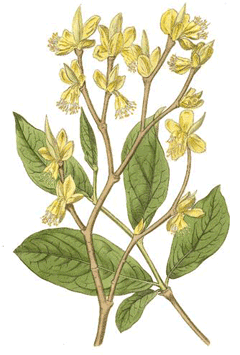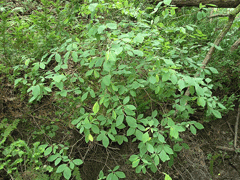 |
|
http://commons.wikimedia.org/wiki/File:Dirca_palustris_-_Edwards.jpg |
 |
|
Translate this page:
Summary
Physical Characteristics

 Dirca palustris is a deciduous Shrub growing to 1.8 m (6ft).
Dirca palustris is a deciduous Shrub growing to 1.8 m (6ft).
See above for USDA hardiness. It is hardy to UK zone 4 and is not frost tender. It is in flower in March. The species is hermaphrodite (has both male and female organs) and is pollinated by Insects.
Suitable for: light (sandy), medium (loamy) and heavy (clay) soils. Suitable pH: mildly acid, neutral and basic (mildly alkaline) soils. It can grow in semi-shade (light woodland) or no shade. It prefers moist soil.
UK Hardiness Map
US Hardiness Map
Synonyms
Plant Habitats
Woodland Garden Sunny Edge; Dappled Shade; Shady Edge;
Edible Uses
References More on Edible Uses
Medicinal Uses
Plants For A Future can not take any responsibility for any adverse effects from the use of plants. Always seek advice from a professional before using a plant medicinally.
Emetic Laxative Pectoral Poultice VD
Leatherwood was employed medicinally by a number of native North American Indian tribes who used it to treat a wide variety of ailments[257]. It is little used in modern herbalism and any use should be carried out with caution since even minute doses can cause salivation and burning of the tongue[222]. A tea made from the bark is laxative[222]. Another report says that it is purgative and emetic, and can produce violent vomiting[235, 257]. An infusion of the roots has been used in the treatment of pulmonary problems[257]. A decoction of the branches has been applied as a poultice to swellings on the limbs[257]. The plant is a folk remedy for toothaches, facial neuralgia and paralysis of the tongue, venereal disease, and has also been used to try and induce pregnancy[222, 257].
References More on Medicinal Uses
The Bookshop: Edible Plant Books
Our Latest books on Perennial Plants For Food Forests and Permaculture Gardens in paperback or digital formats.

Edible Tropical Plants
Food Forest Plants for Hotter Conditions: 250+ Plants For Tropical Food Forests & Permaculture Gardens.
More

Edible Temperate Plants
Plants for Your Food Forest: 500 Plants for Temperate Food Forests & Permaculture Gardens.
More

More Books
PFAF have eight books available in paperback and digital formats. Browse the shop for more information.
Shop Now
Other Uses
Basketry Fibre Hair Paper String
The tough flexible shoots are used in basket making and as a tying material[1, 11, 43, 46, 95]. A rope can be made from the bark fibres[1, 11, 46, 61]. The bark fibres are also used in making paper[189]. The stems are harvested in summer, the leaves are removed and the stems steamed until the fibres can be stripped. The outer and inner barks are separated by scraping or peeling. The fibres are cooked for 2 hours or less with soda ash and then beaten with mallets or put through a blender. The paper is greenish cream in colour[189]. A compound infusion of the roots has been used as a wash to strengthen the hair and make it grow[257].
Special Uses
Scented Plants
References More on Other Uses
Cultivation details
Thrives in a moist peaty soil[1, 11] and a sheltered position[175]. Prefers a reasonably moist humus-rich limy soil according to another report[182]. The flowers are produced in early spring and they are often damaged by frost[1, 200]. They have a soft sweet perfume[245]. The species D. occidentalis A.Gray. is very closely related to this plant[200], so it might have the same uses[K].
References Carbon Farming Information and Carbon Sequestration Information
Temperature Converter
Type a value in the Celsius field to convert the value to Fahrenheit:
Fahrenheit:
The PFAF Bookshop
Plants For A Future have a number of books available in paperback and digital form. Book titles include Edible Plants, Edible Perennials, Edible Trees,Edible Shrubs, Woodland Gardening, and Temperate Food Forest Plants. Our new book is Food Forest Plants For Hotter Conditions (Tropical and Sub-Tropical).
Shop Now
Plant Propagation
Seed - best sown in a cold frame as soon as it is ripe[113]. Remove the fruit flesh since this can inhibit germination[113]. Dried seed will require 2 - 3 months cold stratification[113]. The seed usually germinates in 1 - 6 months at 15°c[175]. When they are large enough to handle, prick the seedlings out into individual pots and grow them on in the greenhouse for at least their first winter. Plant them out into their permanent positions in late spring or early summer, after the last expected frosts. Layering.
Other Names
If available other names are mentioned here
Native Range
NORTHERN AMERICA: Canada (Québec, Nova Scotia, Ontario, New Brunswick), United States (Connecticut, Indiana, Maine, Massachusetts, Michigan, New Hampshire, New Jersey, New York, Ohio, Vermont, West Virginia, Iowa, Minnesota, Missouri, Illinois, Oklahoma, Wisconsin, Alabama, Arkansas, Delaware, Florida (north), Georgia, Kentucky, Louisiana, Maryland, Mississippi, North Carolina, South Carolina, Tennessee, Virginia)
Weed Potential
Right plant wrong place. We are currently updating this section.
Please note that a plant may be invasive in one area but may not in your area so it's worth checking.
Conservation Status
IUCN Red List of Threatened Plants Status :

Growth: S = slow M = medium F = fast. Soil: L = light (sandy) M = medium H = heavy (clay). pH: A = acid N = neutral B = basic (alkaline). Shade: F = full shade S = semi-shade N = no shade. Moisture: D = dry M = Moist We = wet Wa = water.
Now available:
Food Forest Plants for Mediterranean Conditions
350+ Perennial Plants For Mediterranean and Drier Food Forests and Permaculture Gardens.
[Paperback and eBook]
This is the third in Plants For A Future's series of plant guides for food forests tailored to
specific climate zones. Following volumes on temperate and tropical ecosystems, this book focuses
on species suited to Mediterranean conditions—regions with hot, dry summers and cool, wet winters,
often facing the added challenge of climate change.
Read More
Expert comment
Author
L.
Botanical References
1143200
Links / References
For a list of references used on this page please go here
Readers comment
| Add a comment |
|
If you have important information about this plant that may help other users please add a comment or link below. Only comments or links that are felt to be directly relevant to a plant will be included. If you think a comment/link or information contained on this page is inaccurate or misleading we would welcome your feedback at [email protected]. If you have questions about a plant please use the Forum on this website as we do not have the resources to answer questions ourselves.
* Please note: the comments by website users are not necessarily those held by PFAF and may give misleading or inaccurate information.
To leave a comment please Register or login here All comments need to be approved so will not appear immediately.
|
Subject : Dirca palustris
|
|
|
|